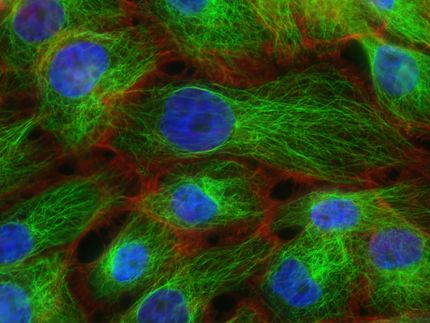A protein provides stress relief
Advertisement
Freiburg researchers have shown a new mechanism via which cells defend themselves against stress. Dr. Kathrin Thedieck and Birgit Holzwarth from the Institute of Biology III and the Cluster of Excellence BIOSS Centre for Biological Signalling Studies of the University of Freiburg have discovered that Astrin, a rarely investigated component of many cells, plays an important part in this process. The scientists demonstrated the stress function of Astrin, which was previously mainly known for its role in cell division. Astrin maybe an important drug target, as tumor cells avoid cell death due to high Astrin levels.

Astrin balances mTORC1 activity via stress granules. Too low or too high mTORC1 activation under stress will cause cell death, but tightly controlled mTORC1 activity is required for stress survival.
© Artwork by Christoph Luchs
Free radicals, much like combustion exhaust gases, arise from external sources or cellular metabolism and cause stress in the body cells. Cellular stress is thought to contribute to the development of age-related diseases including cancer, neurodegenerative diseases, or metabolic disorders. “The protein complex mTORC1 (mammalian target of rapamycin) plays a key role in balancing growth and degradation,” says Dr. Thedieck, junior group leader from Freiburg. Nutrients activate mTORC1, allowing the cell to grow. In addition, mTORC1 helps the cell to cope with moderate stress. However, as mTORC1 activity becomes too high, the cell initiates programmed cell death. “Upon increasing stress, we observe so-called stress granules which prevent mTORC1 hyperactivation and, hence immediate cell death under transient stresses. Until now, however, the molecular mechanism governing this process was unknown,” says Thedieck.
Thedieck and her team in the laboratory of Prof. Dr. Ralf Baumeister at the Faculty of Biology have now demonstrated that Astrin is a molecular link between mTORC1 and stress granules. When confronted with stress, Astrin recruits mTORC1 components to stress granules, thus limiting mTORC1 activity. “When we manipulated the cells to prevent Astrin production, mTORC1 became more active and the cells died much earlier upon stress,” reports Thedieck.
The researchers have applied for a patent to protect their discovery for potential applications in tumor therapy. “Astrin levels are increased in many tumors, and thus inhibit cell death, which is what chemotherapy is actually supposed to bring about. As a result, the tumor cells survive. If we could deprive them of Astrin’s protective effects, we might be able to fight tumors more easily in the future,” explains Thedieck.
























































